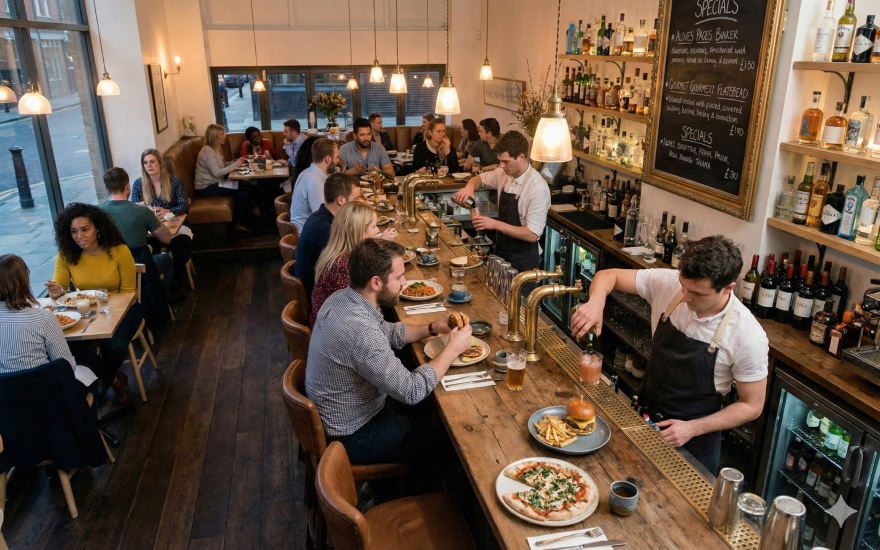Restaurant Work From Home Trends In The Restaurant Industry

Unemployment is near all-time-lows. In 2023, it reached the lowest level that it’s been in 54 years.
The stock market seems to hit a new record high every other night (as of September 2024).
And the Federal Reserve just announced that it will be lowering rates by 50 basis points – a huge boon to any business owners who rely on cheap financing to keep their business running.
That all should be cause for celebration – but the restaurant industry is still struggling.
And why is that?
This article is going to be all about recent work-from-home restaurant trends, specifically focused on “How Does Remote Work Affect the Restaurant Industry?”
We’ll talk about:
- How the Restaurant Labor Market is Being Affected by Work From Home (WFH)
- How Remote Work is Changing the Dining Habits of Consumers
- How Restaurants Can Adapt to These Changes
- And More…
Why Are Restaurants Struggling to Hire Workers?
According to a recent survey by the National Restaurant Association, a whopping 62% of restaurant operators report not having enough employees to meet customer demand, and 79% say they have job openings that are difficult to fill.
You see it every time you go to a cafe, where there’s a line of twenty people and one frantic barista.
You see it every time you go to a restaurant and your food takes 30 minutes longer than it used to.
People tend to point the finger at the pandemic, or they parrot the old trope that “nobody wants to work anymore,” but there’s one not-so-obvious culprit at the heart of the restaurant industry’s hiring woes: Remote work.

The Bad News: Remote Work is Causing a Labor Shortage for Restaurant Owners and Managers
According to Upside, in July 2023, “restaurants were open for four fewer hours per week than they were in 2021.” That’s 5.7% fewer hours than in July 2021 – despite all of the recent advancements that we’ve made in technology that streamline so many restaurant processes.
The reason is actually pretty simple: With more workers than ever preferring to work from home, there’s a smaller labor pool of people who actually want to physically go to a restaurant and serve people.
It’s bad news for owners and operators, but it’s also a sign that the restaurant industry hasn’t kept up with the times and made its employment offers (and advancement opportunities) just as attractive as those in other industries. Many people see working in a restaurant as a stepping stone for their eventual career, not the career itself.
In order to fully understand why, let’s dive into the demographics of remote work…
Remote Work Demographics: What Are the Stats?
Most estimates put the amount of full-time remote workers at 12-14%. This is a massive, nearly two-fold increase from the ~7.1% who worked from home before the pandemic. And that doesn’t count the people who now work from home for at least a few days per week…
MIT says that about 27% of the workforce is working remotely at least some of the time (which would be an additional 12-15% who work remotely).

That would put the remaining 73% of the workforce in a full-time “in office” (or “on site”) position. Many important jobs don’t have the option to work from home, and restaurant workers are no exception.
However, this puts a massive strain on the labor pool for restaurant owners and managers. By and large, workers seem to prefer working remotely. In fact, the majority of workers in 2024 rank remote work as being more important than salary.
Even though many remote work jobs are in finance and technology, the increasing prevalence of remote work jobs are establishing a new normal for the labor pool at large.
Put simply: Why commute twenty minutes each way to bus tables when you could be an admin assistant and stay in your pajamas (with the potential to move up in the future?)
But that isn’t the only way in which remote work is shaping the restaurant industry…
The Impact of Remote Work on Restaurant Dining Habits
With the increasing prevalence of work-from-home arrangements, restaurants are witnessing a change in when and how people dine.
Research reveals that remote workers, particularly during lunch hours, are frequenting restaurants at a higher rate than before. According to a study by Toast, 75% of people working remotely get lunch from a restaurant at least once during the workweek, with 31% dining out for lunch three times a week. Dinner comes in close second, with 73% of remote workers dining out for dinner at least once during the week.
This shift in dining habits is largely driven by the flexibility that comes with remote work. Workers can now step out for lunch at their convenience, and many take advantage of the opportunity to grab a meal they don’t have to prepare themselves.
Moreover, there’s been a notable shift toward takeout meals, driven by the ability to eat comfortably at home while continuing with work tasks. In fact, takeout transactions during lunchtime increased by 7% between 2019 and 2023, underscoring the growing preference for grabbing meals to enjoy at home.

The Changing Lunch Landscape
Since the pandemic and the subsequent shift to remote work, the restaurant lunch hour has evolved.
Prior to 2020, dine-in lunches dominated restaurant transactions, but by Q1 2023, dine-in lunches dropped from 79% to 70%. Meanwhile, according to that same data, takeout orders increased in tandem (as we mentioned above).
These changes reflect how WFH employees often prefer the convenience of ordering food to go, as it allows them to maintain productivity while enjoying a meal at home.
Interestingly, spending patterns have also shifted. The average lunch check has increased by 42% since 2019, with dine-in transactions averaging $24 and takeout transactions averaging $22.
Most people would assume that consumers would spend less on take-out transactions, seeing as they aren’t taking up any space in the restaurant, but that isn’t necessarily the case.
These statistics suggest that despite working from home, many employees are willing to spend more on meals to enhance their dining experience, further emphasizing the importance of offering high-quality, convenient meal options for takeout customers.
Maximizing Evening and Weekend Traffic
Beyond workday lunch and dinner services, remote workers continue to visit their favorite restaurants during nights and weekends. According to Levo, 62% of respondents stated that they return to their go-to workweek restaurants at least once a month on weekends or evenings. This presents a unique opportunity for restaurants to market to their daytime customers and encourage repeat business during off-peak hours.
Effective marketing strategies include loyalty programs, happy hour specials, and targeted communication through email and SMS channels.
For example, restaurants can offer exclusive deals for returning customers or create events that appeal to the work-from-home crowd, ensuring that they remain top of mind even outside of traditional work hours.

Conclusion: What Can Owners Do?
The work-from-home trend has reshaped the restaurant industry, particularly when it comes to workday dining. By understanding the dining habits of remote workers and offering tailored promotions, restaurants can take advantage of the increased flexibility and spending power of this new customer base.
The most important aspect? Making sure that your restaurant has affordable, high-quality meals to-go (and an option for consumers to order those meals, either through an online interface, DoorDash, or Uber). This can capture the interest of busy remote workers who prefer to eat at home.
Solving the labor shortage, however, is a complex issue with no easy solution, but restaurants should find every way that they can to cut costs in other areas in order to offer attractive salaries and benefits to workers. The labor pool is tight, and the only option is to compete.
There’s significant potential for growth as restaurants adapt to the evolving dining needs of the work-from-home workforce.
As remote work continues to thrive, restaurants that proactively embrace these trends are likely to see sustained success, capturing both weekday and weekend business from an increasingly flexible and mobile clientele.
Another way restaurants can improve their business is through all-in-one HR, payroll, and workforce management software. This can streamline many of the processes involved with running a restaurant, allowing business owners to reduce labor costs and make the most of a limited team. Click here to book a demo to learn how Push can streamline your operations.



